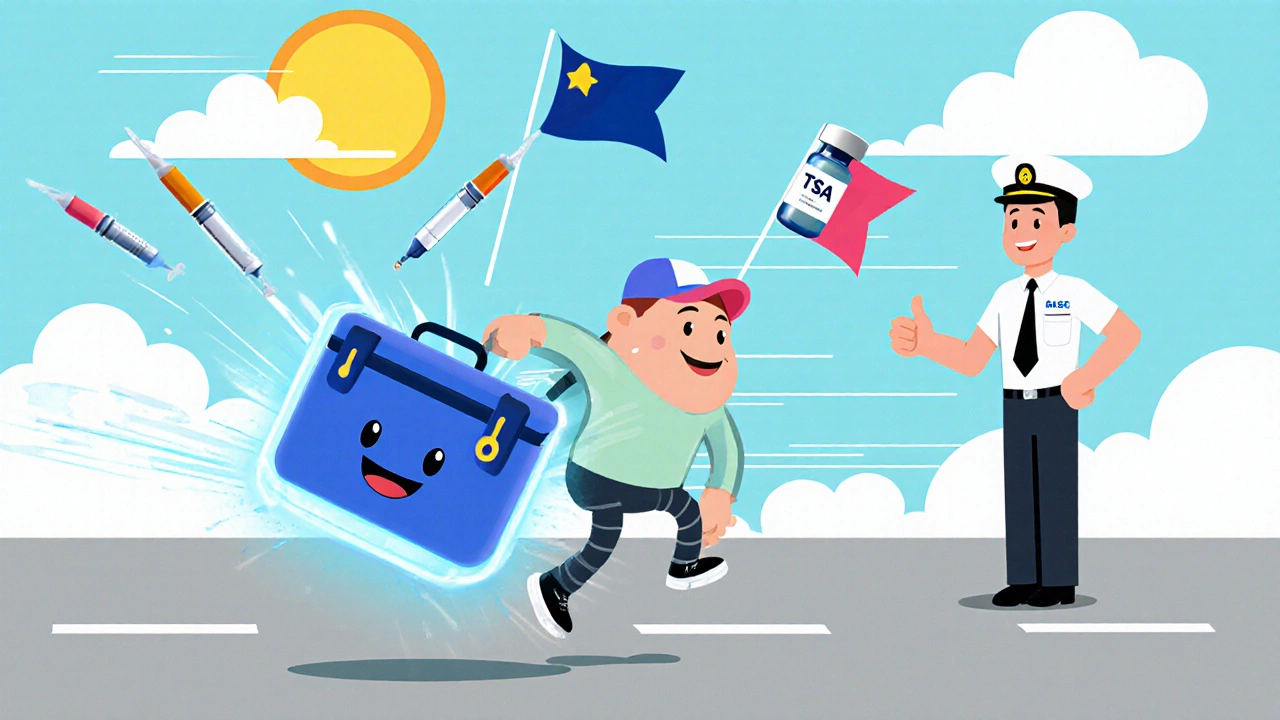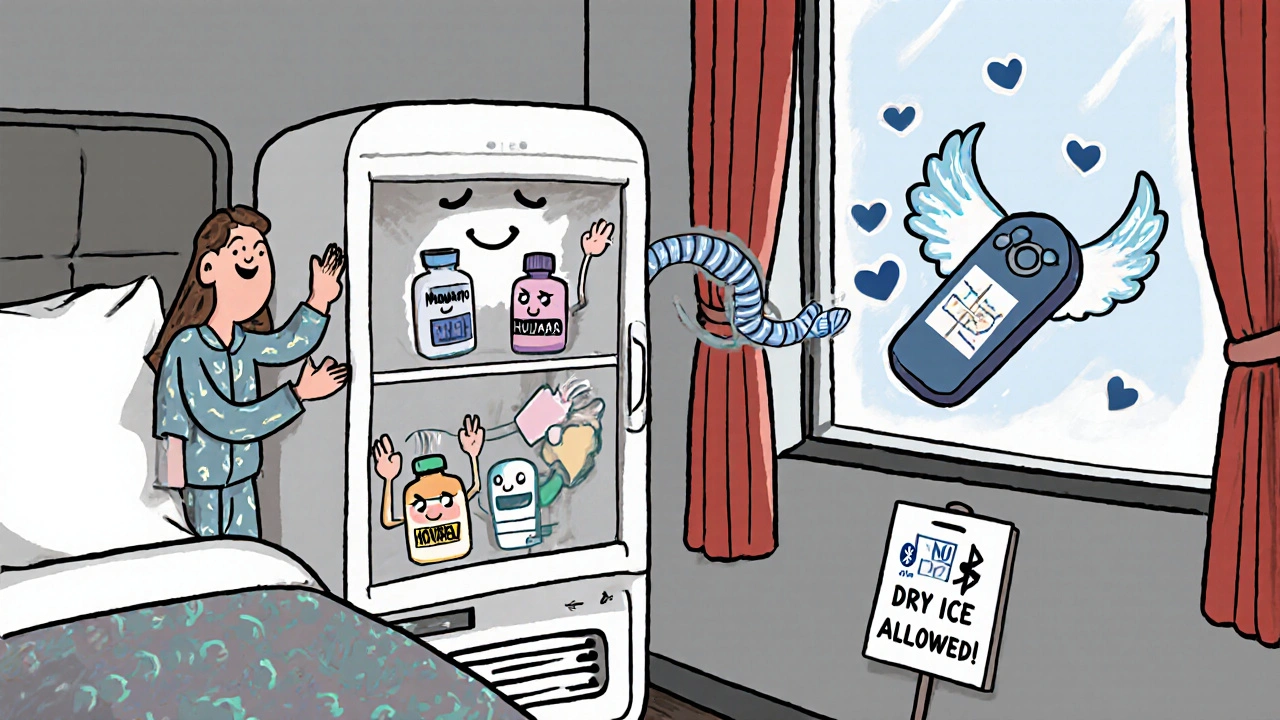
Carrying refrigerated medications while traveling isn’t just about convenience-it’s a matter of safety. If your insulin, Mounjaro, vaccines, or other temperature-sensitive drugs get too warm, they can lose effectiveness fast. Some lose up to 15% of their potency in just one hour outside the 36°F to 46°F (2°C to 8°C) range. That’s not a risk you can afford to take, especially when you’re far from home and your regular pharmacy.
Why Temperature Control Matters More Than You Think
It’s easy to assume that if your medication doesn’t look damaged, it’s still good. But that’s not true. Insulin, for example, starts degrading at 77°F (25°C), losing about 10% of its strength per day. Biologics like tirzepatide (Mounjaro) can handle room temperature for up to 21 days, but that’s an exception-not the rule. Most injectables, hormones, and vaccines need consistent cold. Even brief spikes above 46°F can reduce effectiveness, and repeated warming and cooling cycles can cut potency by as much as 40%, according to clinical pharmacists at Memorial Sloan Kettering.
And it’s not just about heat. Freezing is just as dangerous. Dry ice, which some travelers mistakenly use, hits -109°F (-78°C). That can freeze insulin solid, destroying its structure. The American Diabetes Association explicitly warns against it. Even standard coolers with ice cubes can freeze medications if they’re packed too tightly or left too long. That’s why medical-grade coolers have separate compartments-they keep meds from touching cold packs directly.
What Types of Medications Need Refrigeration?
You might think only insulin needs cold storage. But the list is longer than most realize. About 25% of prescription medications require refrigeration, according to the FDA. That includes:
- Insulin (all types, including rapid-acting and long-acting)
- Biologics like Mounjaro, Ozempic, Wegovy, and Humira
- Vaccines (including flu, shingles, and COVID boosters)
- Hormone therapies like growth hormone and certain fertility drugs
- Some antibiotics (especially injectable forms like vancomycin)
- Enzyme replacements and specialty infusions
If you’re unsure whether your medication needs refrigeration, check the manufacturer’s package insert. Pharmacists are required to provide this info-83% of them do so when asked, according to the National Community Pharmacists Association. Don’t guess. Ask.
Top Cooling Options for Travel in 2025
Not all coolers are created equal. Here’s how the main options stack up:
| Product | Duration | Power Needed | Weight | Temp Range | Best For |
|---|---|---|---|---|---|
| 4AllFamily Explorer | 50-72 hours | USB rechargeable | 1.2 lbs | 36-45°F (2-8°C) | Flights, road trips, multi-day travel |
| Armoa Portable Medical Fridge | 48 hours | AC or 12V car plug | 6.2 lbs | 36-46°F (2-8°C) | Extended stays, camping, RVs |
| SUNMON Insulin Cooler Bag | 8-12 hours | None (ice packs) | 0.6 lbs | Up to 79°F (26°C) | Day trips, short flights |
| MedAngel ONE | Depends on cooler | Bluetooth, battery-powered | 0.1 lbs | Monitoring only | Adding real-time alerts to any cooler |
| Pre-frozen Gel Packs (e.g., Novo Nordisk) | 12-24 hours | None | Varies | 36-46°F (2-8°C) | Short trips, backup |
The 4AllFamily Explorer stands out for most travelers. It’s lightweight, TSA-approved, and keeps meds cool for over 50 hours-even in 104°F heat. Its Biogel Freeze Packs are pre-chilled and designed to stay in the safe range longer than regular ice. The newer 2.0 version even sends alerts to your phone if temps creep out of range. That’s huge for peace of mind.
For longer trips or if you’re staying in a hotel without a reliable fridge, the Armoa is the gold standard. It actively cools like a mini-fridge, so you don’t have to worry about ice melting. But it’s heavy and needs a power source. Not ideal for flights.
For quick trips-like a day at the beach or a short flight-the SUNMON bag works. But it’s not for extended use. Most users report temps rising above 46°F after 12 hours, especially in hot climates.

How to Use Cooling Gear Right
Even the best cooler won’t help if you use it wrong. Here’s what actually works:
- Pre-freeze gel packs for 24 hours-not 12. Most users underestimate this. Cold packs need full freeze time to reach peak performance.
- Don’t let meds touch ice or gel packs-use the divider compartment. Direct contact can freeze insulin and ruin it.
- Use waterproof bags to wrap vials or pens. Condensation from melting ice can damage packaging and labels. PWSA USA found this prevents 98% of moisture-related damage.
- Carry a digital thermometer-not just a guess. A $15 thermometer with a probe can be your lifeline. The CDC recommends continuous monitoring for critical meds.
- Refresh cooling packs at hotel ice machines-87% of travelers who do this report zero temperature excursions.
Pro tip: Always request a mini-fridge when booking your hotel. 92% of major chains like Marriott, Hilton, and Hyatt will provide one free of charge if you ask. Don’t assume the room fridge is cold enough-many run at 50°F, which is too warm for insulin.
TSA Rules You Can’t Afford to Ignore
Security checkpoints are a minefield if you’re unprepared. TSA requires you to:
- Declare refrigerated medications and coolers at the checkpoint
- Place them in a separate bin for X-ray screening
- Have prescription labels visible on all medication containers
You’re not required to show a doctor’s note, but carrying one reduces delays by 75%, according to TSA data. Many travelers also carry a printed copy of the manufacturer’s storage guidelines-pharmacists will give you this on request. It helps TSA agents understand why you’re carrying a cooler.
Never check your meds in luggage. Checked baggage can sit in unrefrigerated cargo holds for hours. Always carry them in your personal item or carry-on. And never, ever use dry ice. It’s banned on planes for safety reasons-and it will freeze your meds.
What to Do If Your Meds Get Too Warm
Accidents happen. Maybe your cooler died on a long layover. Or you forgot to pre-freeze the packs. Here’s what to do:
- If temps were above 46°F for less than 2 hours: The medication is likely still safe. Use it.
- If temps were above 46°F for 2-8 hours: Call your pharmacist. They can advise based on the specific drug.
- If temps were above 46°F for more than 8 hours: Do not use it. Dispose of it safely and get a replacement.
Don’t try to “save” degraded meds. The risk of ineffective treatment-especially with insulin-is too high. Always carry a backup supply. Many travelers keep an extra insulin pen in their wallet or purse, stored in a small insulated pouch.

Real Stories: What Works in the Real World
On Reddit’s r/diabetes, a user shared how their 4AllFamily cooler kept insulin at 41°F during a 68-hour flight sequence across three time zones. Another traveler used a styrofoam cooler with four medical-grade ice packs on a 10-day trip to Europe, rotating them every 12 hours. Temperatures stayed between 38°F and 44°F the whole time.
On the flip side, 63% of negative Amazon reviews for cheap coolers mention temps hitting 50°F+ within 24 hours. One parent reported their child’s growth hormone degraded after a 16-hour car ride in a lunchbox cooler. The meds were still cold to the touch-but not cold enough.
These aren’t outliers. They’re common mistakes. The key is using gear designed for medical use-not a regular cooler from the camping store.
Future of Travel Cooling: What’s Coming in 2026
The market is evolving fast. The MedAngel CORE, launching in early 2024, promises 120 hours of cooling using advanced phase-change materials. Early tests show it struggles in tropical heat, but improvements are coming. Meanwhile, 78% of major drugmakers are building apps that log your medication’s temperature history. That means in the near future, your phone could show if your insulin was exposed to unsafe temps during your trip-before you even use it.
Health systems are also stepping in. 41% of hospitals and clinics now provide free travel cooling kits to patients on biologics, up from just 12% in 2019. If you’re on a high-cost medication, ask your provider-they might have one you can borrow.
Final Checklist Before You Leave
Before you pack your bag, run through this:
- ✔️ Confirm all meds need refrigeration (check packaging or ask pharmacist)
- ✔️ Choose a cooler rated for at least 50 hours of cooling
- ✔️ Freeze gel packs for 24+ hours before departure
- ✔️ Pack meds in a waterproof bag, away from direct contact with cold packs
- ✔️ Bring a backup supply and a small insulated pouch for emergencies
- ✔️ Request a mini-fridge at your hotel
- ✔️ Print manufacturer storage guidelines and prescription labels
- ✔️ Carry a digital thermometer with a probe
- ✔️ Declare meds at TSA and keep them in your carry-on
Traveling with refrigerated meds isn’t complicated-it just needs planning. Get the right gear, follow the steps, and you’ll arrive at your destination with your meds fully effective and your peace of mind intact.
Can I use a regular cooler for my insulin?
You can, but it’s risky. Regular coolers don’t maintain consistent temperatures and often let meds get too cold (freezing) or too warm (degrading). Medical-grade coolers like the 4AllFamily Explorer have separate compartments and are tested to stay within 36-46°F for over 50 hours. A standard cooler might work for a 6-hour flight, but not for multi-day trips or hot climates.
How long can insulin sit out at room temperature?
Most insulin can be stored at room temperature (up to 86°F or 30°C) for up to 28 days after opening. But that’s for daily use, not travel. During travel, especially in hot weather, it’s safer to keep it refrigerated. Temperatures above 77°F cause faster degradation-up to 10% per day. Don’t rely on the 28-day rule while traveling.
Is dry ice safe for transporting insulin on a plane?
No. Dry ice is banned on commercial flights for safety reasons-it can cause suffocation and extreme cold burns. More importantly, it can freeze insulin solid, destroying its structure. The American Diabetes Association and TSA both prohibit its use for medication transport. Always use medical-grade gel packs instead.
Do I need a doctor’s note to fly with refrigerated meds?
TSA doesn’t require a doctor’s note, but it’s strongly recommended. Carrying a printed note or prescription label reduces screening delays by 75%. Some international destinations may require documentation, so always check entry rules. Your pharmacist can provide a letter explaining your medication’s storage needs.
What if my medication cooler breaks during travel?
If your cooler fails, act fast. Use hotel ice machines to refill gel packs or ask the front desk for a mini-fridge. If you’re in a pinch, wrap meds in a towel and place them in the coolest spot available-like a bathroom cabinet or basement. Never leave them in direct sunlight or near a heater. If you suspect degradation, don’t use the meds. Contact your pharmacy or local clinic for a replacement.
Can I carry refrigerated meds in my checked luggage?
Never. Checked baggage can sit in unrefrigerated cargo holds for hours or even days. Temperatures can soar above 100°F or drop below freezing. Always carry refrigerated medications in your carry-on. TSA allows medical items as exceptions to liquid limits, so you can bring your cooler without issue.
How do I know if my medication has gone bad?
For insulin: Look for cloudiness, clumping, or discoloration. If it looks different from when you opened it, don’t use it. For biologics: Check for particles, discoloration, or unusual odor. If in doubt, discard it. Temperature monitoring is the best way to avoid this-use a digital thermometer or Bluetooth monitor to track exposure.
Traveling with refrigerated meds isn’t about fear-it’s about control. With the right tools and preparation, you can go anywhere without risking your health. The technology exists. The knowledge is available. Now it’s just about taking the steps to protect what keeps you well.

 Health and Wellness
Health and Wellness